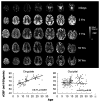Applications of arterial spin labeled MRI in the brain
- PMID: 22246782
- PMCID: PMC3326188
- DOI: 10.1002/jmri.23581
Applications of arterial spin labeled MRI in the brain
Abstract
Perfusion provides oxygen and nutrients to tissues and is closely tied to tissue function while disorders of perfusion are major sources of medical morbidity and mortality. It has been almost two decades since the use of arterial spin labeling (ASL) for noninvasive perfusion imaging was first reported. While initial ASL magnetic resonance imaging (MRI) studies focused primarily on technological development and validation, a number of robust ASL implementations have emerged, and ASL MRI is now also available commercially on several platforms. As a result, basic science and clinical applications of ASL MRI have begun to proliferate. Although ASL MRI can be carried out in any organ, most studies to date have focused on the brain. This review covers selected research and clinical applications of ASL MRI in the brain to illustrate its potential in both neuroscience research and clinical care.
Copyright © 2012 Wiley Periodicals, Inc.
Figures






References
-
- Detre JA, Subramanian VH, Mitchell MD, et al. Measurement of regional cerebral blood flow in cat brain using intracarotid 2H2O and 2H NMR imaging. Magn Reson Med. 1990;14(2):389–395. - PubMed
-
- Eleff SM, Schnall MD, Ligetti L, et al. Concurrent measurement of cerebral blood flow, sodium, lactate, and high-energy phosphate metabolism using 19F, 23Na, 1H, and 31P nuclear magnetic resonance spectroscopy. Magn Reson Med. 1988;7(4):412–424. - PubMed
-
- Detre JA, Eskey CJ, Koretsky AP. Measurement of cerebral blood flow in rat brain using trifluoromethane and 19F-NMR. Magn Reson Med. 1990;15(1):45–57. - PubMed
-
- Detre JA, Leigh JS, Williams DS, Koretsky AP. Perfusion imaging. Magn Reson Med. 1992;23(1):37–45. - PubMed
Publication types
MeSH terms
Substances
Grants and funding
LinkOut - more resources
Full Text Sources
Medical
Research Materials

